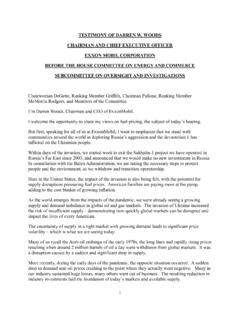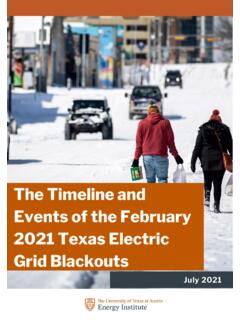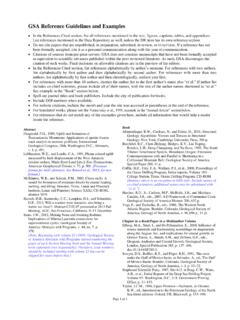Transcription of Written testimony of David Lawler Chairman and President ...
1 Written testimony of David Lawler Chairman and President , bp America Inc. Submitted to the House Committee on Energy and Commerce Subcommittee on Oversight and Investigations April 6, 2022. Chairwoman DeGette, Ranking Member Griffith and Members of the Subcommittee, my name is David Lawler . I am the Chairman and President of bp America. Thank you for the opportunity to appear before you today. I appreciate the Subcommittee's attention to the significant hardships that families and businesses in the United States are feeling due to the rising cost of energy. bp shares these concerns and is committed to working with policymakers and across our businesses to meet these near-term needs while also continuing to transition bp toward a low-carbon future.
2 I am a native of Denver. I graduated from the Colorado School of Mines with a Bachelor of Science in petroleum engineering before earning an MBA from Tulane University. I joined bp in 2014 as the CEO of bp's lower-48 business, now called bpx Energy. In the summer of 2020, I assumed the duties of Chairman and President of bp America. bp has a 150-year history in the United States, and we're committed to America for the long term. Of our more than 65,000 employees in over 65 countries, more than 12,000 work here in the United States. bp has a larger presence in the US than in any other country in the world, with nearly every major bp global business active here. We invested more than $130 billion in the US between 2005 and 2021.
3 Bp's business activities support nearly a quarter million American jobs and contributed about $60 billion to the national economy each year. Before continuing with my testimony , I want to acknowledge the crisis in Ukraine. We are witnessing an act of aggression by Russia that is having tragic humanitarian consequences for the region. Our hearts go out to the people of Ukraine and all of those impacted. bp continues to support those affected in Ukraine and the wider region. At the same time, we are helping ensure that the energy supply remains secure, given that Russian oil and gas is deeply integrated into Europe's energy system. Russia's actions are playing a major role in driving up global oil and natural gas prices.
4 Bp recognizes the pressure high energy prices place on people and businesses, and we are working hard to supply more energy to the world. OIL AND REFINED PRODUCTS MARKETS. The price of globally traded oil, gasoline and other refined products are driven by international markets. Energy markets are complex and global in nature. This means that products like refined fuel reach end consumers through several different paths along the supply chain. The retail price of fuel is set competitively, based on product cost and conditions in specific local markets. The market price of crude oil is the largest determinant of the price, but it is not the only component. Refining costs and capacity, margins, transportation costs and other inputs also affect the wholesale price, as well as the costs and margins charged by distributors and retailers.
5 Taxes and other costs levied by government at the local, state and federal levels also affect the retail price. IMPORTANCE OF ENERGY TRANSITION. Current events could have lasting impacts on global economic and energy systems and the energy transition. This reinforces the wide range of uncertainty in the future that was highlighted by bp's most recent Energy Outlook. Understanding this range helps bp shape its strategy, increasing our resilience to the different speeds and ways in which the energy system may transition during the next 30 years. The bottom line is that the current volatile energy markets underscore the need to invest in reliable energy, both low and zero-carbon sources as well as resilient hydrocarbons.
6 This is the heart of bp's transformation from an international oil company focused on producing resources to an integrated energy company focused on delivering solutions for customers. Globally we are aiming to increase the proportion of capital expenditure in transition growth businesses to more than 40 percent by 2025 and around 50 percent by 2030. These investments will be focused on five areas: bioenergy, hydrogen, renewables, convenience and EV charging. And bp is already in action toward this transformation. BP'S NET ZERO AMBITION. In 2020, bp established a new purpose: reimagining energy for people and our planet. At the same time, we announced a new ambition: to become a net zero company by 2050 or sooner and to help the world get to net zero.
7 Bp aims to be net zero across operations, production and sales by 2050. or sooner which is unique among our peers. bp also set several nearer term targets and aims along our path to reach net zero by 2050 or sooner. We're aiming to cut the emissions from our operations in half on an absolute basis by 2030 and to reduce the emissions arising from the carbon content of our oil and gas production by 35 to 40 percent also on an absolute basis during the same time and against the same baseline year of 2019. Natural gas increasingly decarbonized over time has a pivotal role to play in global efforts to reach net zero. And tackling methane emissions is vital if natural gas is to play its fullest role in the energy transition.
8 Bp recognizes the near-term importance of minimizing methane emissions from the oil and gas industry across the value chain. We're aiming for a methane management program with zero routine flaring in our US onshore operations by 2025 and a global methane intensity target of percent, based on our industry-leading measurement approach. INVESTING IN LOW CARBON ENERGY. In 2020, bp invested more than $750 million in low-carbon energy sources, roughly 50 percent more than 2019. In 2021, that number increased to $ billion. Between 2019 and 2021, bp also quadrupled its global renewables development pipeline from 6GW to We intend to continue investing in low carbon energy sources in the years ahead.
9 By 2025, we are targeting to grow our low-carbon investments to $3 to 4 billion per year. By the end of the decade, we aim to invest $4 to 6 billion per year, or roughly a third of our projected capital expenditures, in low-carbon energy. 2. A large portion of these low-carbon investments are being made in the United States. In 2020, bp announced a $ billion investment in a 50:50 partnership in Equinor's two offshore wind leases off the coasts of New York and Massachusetts. Between them, we aim to develop of low- carbon energy, or enough to power more than 2 million homes every year. In June 2021, bp announced we were acquiring up to 9GW of solar projects in the US from 7X. Energy for $220 million.
10 Developing these could help bp meet nearly 20 percent of our global goal of having developed 50GW of renewable energy capacity by 2030. Accelerating low-carbon energy deployment is not only important for combating climate change, but it also reduces US exposure to disruptions in the supply of hydrocarbons. INVESTING IN RESILIENT HYDROCARBONS. While steadily increasing our investment in low carbon energy, in the near-term we plan to continue making disciplined investments in resilient hydrocarbons here in the United States. Resilient hydrocarbons are intended to withstand volatility in the market and connected to nearby pre-existing infrastructure as much as possible, resulting in fewer emissions on the way to people and businesses.




![[DISCUSSION DRAFT] TH D CONGRESS SESSION H. R. ll](/cache/preview/4/0/a/d/4/2/1/d/thumb-40ad421dbafdce194f0ad7b8bca5f144.jpg)






